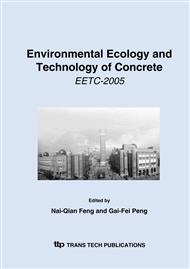p.248
p.255
p.263
p.269
p.275
p.282
p.288
p.301
p.308
Chemical Durability Investigation of Magnesium Phosphosilicate Cement
Abstract:
The magnesium phosphosilicate cement (MPSC) is a novel inorganic binder, it sets quickly and has very high strength. Also, it is a promising material for the sustainable development. In the present study, the durability of MPSC were investigated, including deicer scaling resistance under freezing-thawing cycles, chemical corrosion resistance in sodium sulfate and magnesium sulfate solutions, and wet-dry resistance in fresh and natural sea water. For comparison, Portland cement samples were also prepared for parallel tests. Test results showed that the chemical durability of MPSC is superior that of Portland cement. The causes of the high performance may be attributed to the low water demand and a reasonable microstructure of hardened paste matrix.
Info:
Periodical:
Pages:
275-281
Citation:
Online since:
January 2006
Authors:
Price:
Сopyright:
© 2006 Trans Tech Publications Ltd. All Rights Reserved
Share:
Citation:


